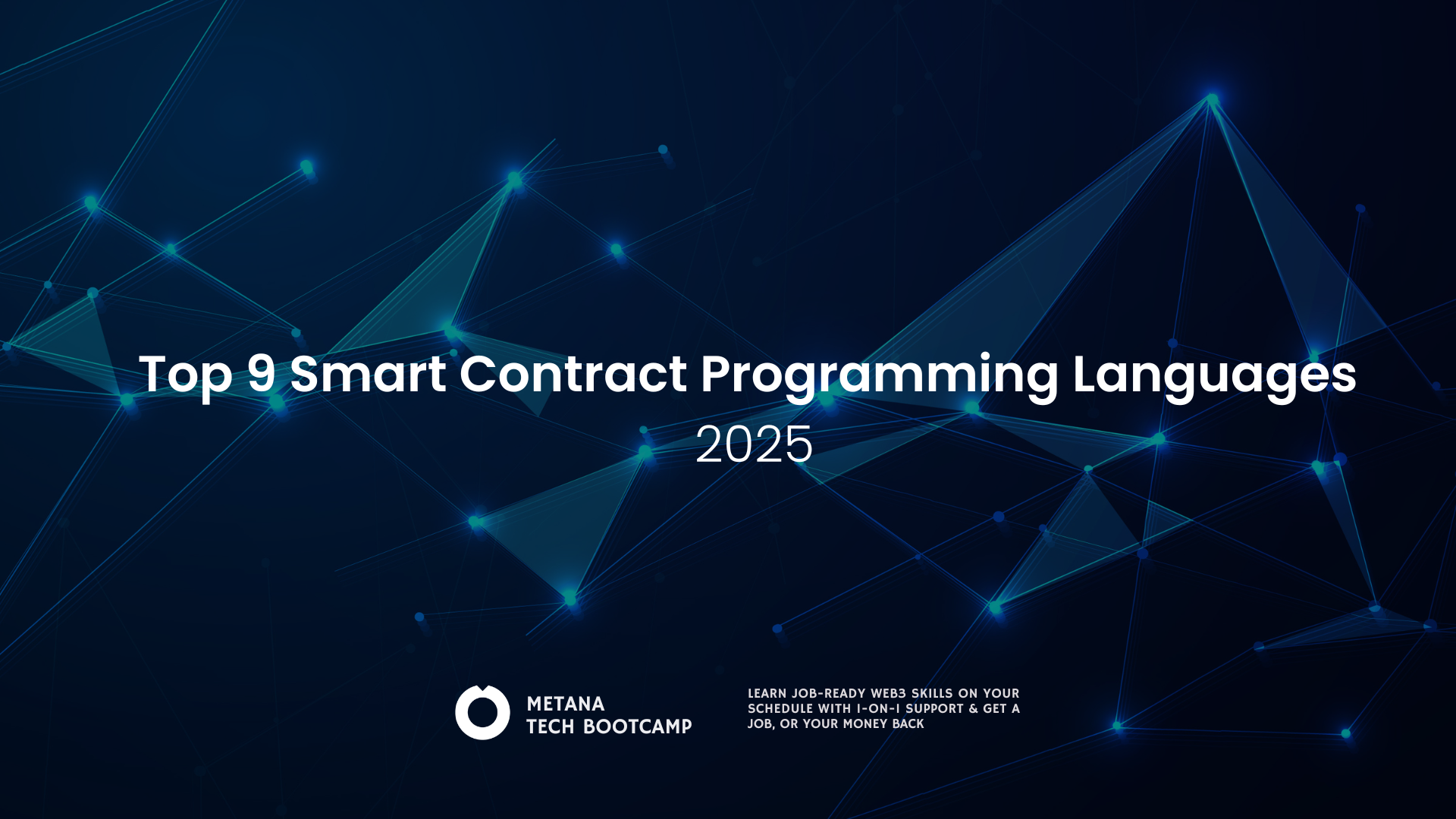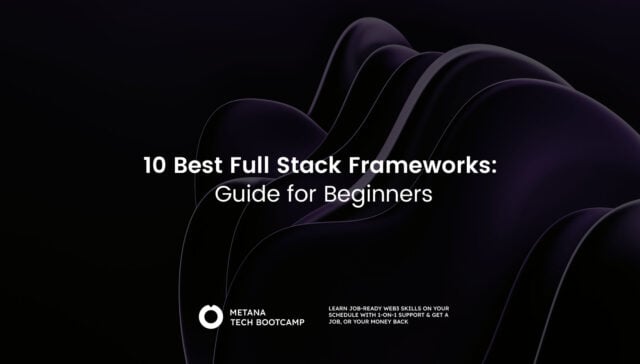TLDR; Smart Contract Languages
- Solidity – Ethereum/EVM chains, most popular, beginner-friendly
- Vyper – Ethereum/EVM, Python-like, security-focused
- Rust – Solana/Polkadot/Near, high-performance, advanced
- Cairo – StarkNet L2, zero-knowledge proofs, cutting-edge
- Move – Aptos/Sui, resource-oriented, asset safety
- Clarity – Stacks/Bitcoin L2, decidable, Bitcoin integration
- Motoko – Internet Computer, actor model, persistent storage
- Cadence – Flow blockchain, NFT-focused, resource-oriented
- Ink! – Polkadot parachains, Rust-based DSL, cross-chain ready
What is a Solidity Smart Contract?
A Solidity smart contract is a program that runs on the Ethereum blockchain, allowing transactions and agreements to execute automatically when predefined conditions are met. Written in the Solidity programming language, these contracts are self-executing with the terms of the agreement directly embedded in the code. Once deployed to the blockchain, smart contracts are immutable and transparent, meaning they can’t be changed or tampered with. They enable secure and efficient interactions between parties without needing intermediaries, making them a key component in decentralized applications (dApps), decentralized finance (DeFi), token creation, and more.
9 Smart Contract Programming Languages in 2025
1. Solidity
Platform: Ethereum Virtual Machine (EVM) and EVM-compatible chains
Market Share: ~65% of all smart contracts
Difficulty: Beginner to Intermediate
Key Features
- Static Typing: Compile-time error detection and type safety
- Contract Inheritance: Object-oriented programming with inheritance support
- Modifier System: Reusable code blocks for access control and validation
- Assembly Integration: Inline assembly for gas optimization
- Event Logging: Built-in event system for dApp integration
Code Example
pragma solidity ^0.8.19;
contract TokenVault {
mapping(address => uint256) private balances;
modifier onlyPositiveAmount(uint256 amount) {
require(amount > 0, "Amount must be positive");
_;
}
function deposit() external payable onlyPositiveAmount(msg.value) {
balances[msg.sender] += msg.value;
emit Deposited(msg.sender, msg.value);
}
event Deposited(address indexed user, uint256 amount);
}
Strengths
- Largest developer community and extensive documentation
- Rich ecosystem with frameworks like Hardhat, Truffle, and Foundry
- Wide blockchain compatibility (Ethereum, Polygon, BSC, Avalanche)
- Mature debugging tools and security analyzers
Weaknesses
- Susceptible to reentrancy and integer overflow attacks
- Higher gas costs compared to some alternatives
- Complex syntax can lead to developer errors
Best For
- DeFi protocols, NFT marketplaces, DAOs, and multi-chain applications
2. Vyper
Platform: Ethereum Virtual Machine (EVM)
Market Share: ~8% of EVM smart contracts
Difficulty: Beginner to Intermediate
Key Features
- Python-like Syntax: Clean, readable code structure
- Security by Design: Eliminates dangerous features like recursion and infinite loops
- Bounded Loops: All loops must have a maximum iteration count
- Overflow Protection: Built-in SafeMath equivalent functionality
- Simplified Inheritance: Single inheritance only to reduce complexity
Code Example
# @version ^0.3.7
event Transfer:
sender: indexed(address)
receiver: indexed(address)
amount: uint256
balances: HashMap[address, uint256]
total_supply: public(uint256)
@external
def transfer(receiver: address, amount: uint256) -> bool:
assert self.balances[msg.sender] >= amount, "Insufficient balance"
self.balances[msg.sender] -= amount
self.balances[receiver] += amount
log Transfer(msg.sender, receiver, amount)
return True
Strengths
- More secure by default due to restricted feature set
- Lower gas consumption than Solidity in many cases
- Easier to audit due to simplified syntax
- Strong compile-time checks prevent common vulnerabilities
Weaknesses
- Limited ecosystem compared to Solidity
- Fewer advanced features for complex applications
- Smaller developer community and fewer learning resources
Best For
- Security-critical financial contracts, simple DeFi protocols, and educational projects
3. Rust
Platform: Solana, Polkadot, Near Protocol, Cosmos
Market Share: ~15% of non-EVM smart contracts
Difficulty: Intermediate to Advanced
Key Features
- Memory Safety: Zero-cost abstractions with compile-time memory management
- Performance: Near C++ speed with safety guarantees
- Concurrency: Built-in support for parallel processing
- Pattern Matching: Powerful control flow with match expressions
- Cargo Ecosystem: Rich package manager and build system
Code Example (Solana)
use solana_program::{
account_info::{next_account_info, AccountInfo},
entrypoint,
entrypoint::ProgramResult,
program_error::ProgramError,
pubkey::Pubkey,
};
entrypoint!(process_instruction);
pub fn process_instruction(
program_id: &Pubkey,
accounts: &[AccountInfo],
instruction_data: &[u8],
) -> ProgramResult {
let accounts_iter = &mut accounts.iter();
let account = next_account_info(accounts_iter)?;
if !account.is_signer {
return Err(ProgramError::MissingRequiredSignature);
}
// Process the instruction
match instruction_data[0] {
0 => initialize_account(account),
1 => transfer_tokens(accounts, instruction_data),
_ => Err(ProgramError::InvalidInstructionData),
}
}
Strengths
- Exceptional performance and low-level control
- Strong type system prevents many runtime errors
- Growing ecosystem with excellent tooling
- Cross-platform compatibility
Weaknesses
- Steep learning curve for developers new to systems programming
- Longer development time due to strict compiler
- Fewer blockchain-specific libraries compared to Solidity
Best For
- High-performance DeFi protocols, gaming applications, and infrastructure projects
4. Cairo
Platform: StarkNet (Ethereum Layer 2)
Market Share: ~3% but rapidly growing
Difficulty: Advanced
Key Features
- STARK Proofs: Native support for scalable, transparent cryptographic proofs
- Cairo VM: Custom virtual machine optimized for proving
- Field Arithmetic: Built-in support for finite field operations
- Provable Programs: Mathematical guarantees of execution correctness
- Zero-Knowledge Privacy: Computations can be verified without revealing inputs
Code Example
%lang starknet
from starkware.cairo.common.cairo_builtins import HashBuiltin
from starkware.starknet.common.syscalls import get_caller_address
@storage_var
func balance(user: felt) -> (res: felt) {
}
@external
func deposit{syscall_ptr: felt*, pedersen_ptr: HashBuiltin*, range_check_ptr}(
amount: felt
) {
let (caller) = get_caller_address();
let (current_balance) = balance.read(caller);
balance.write(caller, current_balance + amount);
return ();
}
Strengths
- Cutting-edge zero-knowledge technology
- Massive scalability improvements (1000x+ throughput)
- Mathematical proof of correctness
- Lower transaction costs on Layer 2
Weaknesses
- Extremely steep learning curve
- Limited tooling and development resources
- Complex debugging and testing
- Requires deep cryptography knowledge
Best For
- Privacy-preserving applications, high-frequency trading, and scalable DeFi
5. Move
Platform: Aptos, Sui, originally Diem
Market Share: ~5% of total smart contract deployments
Difficulty: Intermediate to Advanced
Key Features
- Resource-Oriented Programming: Assets are first-class resources with move semantics
- Linear Types: Resources cannot be copied or accidentally lost
- Formal Verification: Built-in support for mathematical proofs
- Module System: Clean organization and code reuse
- Bytecode Verification: Runtime safety checks
Code Example
module 0x1::SimpleWallet {
use std::signer;
use aptos_framework::coin::{Self, Coin};
use aptos_framework::aptos_coin::AptosCoin;
struct Wallet has key {
balance: Coin<AptosCoin>,
}
public entry fun create_wallet(account: &signer) {
let wallet = Wallet {
balance: coin::zero<AptosCoin>(),
};
move_to(account, wallet);
}
public entry fun deposit(account: &signer, amount: u64) acquires Wallet {
let wallet = borrow_global_mut<Wallet>(signer::address_of(account));
let deposit_coin = coin::withdraw<AptosCoin>(account, amount);
coin::merge(&mut wallet.balance, deposit_coin);
}
}
Strengths
- Revolutionary resource safety model
- Prevents common asset management bugs
- Strong formal verification capabilities
- Clean, modern syntax design
Weaknesses
- Limited blockchain ecosystem adoption
- Fewer developers familiar with resource-oriented programming
- Still evolving tooling and documentation
Best For
- Asset management systems, NFT platforms, and financial applications requiring strict resource safety
6. Clarity
Platform: Stacks (Bitcoin Layer 2)
Market Share: ~2% but growing with Bitcoin DeFi
Difficulty: Intermediate
Key Features
- Decidable Language: Static analysis can determine all possible execution paths
- Bitcoin Integration: Direct access to Bitcoin state and transactions
- Type Safety: Strong typing system prevents runtime errors
- Interpreted Execution: No compilation step, direct source code execution
- Predictable Costs: Gas costs are deterministic and calculable
Code Example
(define-data-var counter uint u0)
(define-public (increment)
(let ((current-value (var-get counter)))
(var-set counter (+ current-value u1))
(ok (var-get counter))))
(define-read-only (get-counter)
(var-get counter))
(define-public (transfer-stx (amount uint) (recipient principal))
(stx-transfer? amount tx-sender recipient))
Strengths
- Unique Bitcoin integration capabilities
- Complete decidability enables perfect static analysis
- No compiler bugs since code is interpreted
- Growing Bitcoin DeFi ecosystem
Weaknesses
- Limited to Stacks ecosystem
- Lisp-like syntax may be unfamiliar to many developers
- Smaller community and fewer resources
Best For
- Bitcoin-based DeFi, cross-chain Bitcoin applications, and projects requiring formal verification
7. Motoko
Platform: Internet Computer (IC)
Market Share: ~1% but unique capabilities
Difficulty: Intermediate
Key Features
- Actor Model: Native support for concurrent, distributed computing
- Orthogonal Persistence: Automatic state management without databases
- Candid Integration: Type-safe inter-service communication
- WebAssembly Target: High-performance execution environment
- Async/Await: Modern asynchronous programming patterns
Code Example
import Time "mo:base/Time";
import Map "mo:base/HashMap";
actor TokenLedger {
private stable var totalSupply : Nat = 0;
private var balances = Map.HashMap<Principal, Nat>(10, Principal.equal, Principal.hash);
public func transfer(to: Principal, amount: Nat) : async Bool {
let caller = msg.caller;
switch (balances.get(caller)) {
case null { false };
case (?balance) {
if (balance >= amount) {
balances.put(caller, balance - amount);
switch (balances.get(to)) {
case null { balances.put(to, amount); };
case (?toBalance) { balances.put(to, toBalance + amount); };
};
true
} else { false }
};
}
};
}
Strengths
- Revolutionary orthogonal persistence
- Built for internet-scale applications
- Native multi-canister architecture
- Strong type system with modern features
Weaknesses
- Tied exclusively to Internet Computer
- Smaller ecosystem and developer base
- Different programming paradigms may require learning curve
Best For
- Large-scale dApps, social media platforms, and applications requiring persistent storage
8. Cadence
Platform: Flow Blockchain
Market Share: ~2% focused on NFTs and gaming
Difficulty: Intermediate
Key Features
- Resource-Oriented Programming: Similar to Move but with different design philosophy
- Capability-Based Security: Fine-grained access control
- Ergonomic Design: Developer-friendly syntax and semantics
- Built-in NFT Support: Native non-fungible token primitives
- Type Safety: Strong static typing with safety guarantees
Code Example
pub contract SimpleNFT {
pub var totalSupply: UInt64
pub resource NFT {
pub let id: UInt64
pub let metadata: {String: String}
init(metadata: {String: String}) {
self.id = SimpleNFT.totalSupply
self.metadata = metadata
SimpleNFT.totalSupply = SimpleNFT.totalSupply + 1
}
}
pub fun createNFT(metadata: {String: String}): @NFT {
return <-create NFT(metadata: metadata)
}
init() {
self.totalSupply = 0
}
}
Strengths
- Excellent for NFT and gaming applications
- Resource safety prevents common asset bugs
- Growing ecosystem in digital collectibles
- User-friendly account model
Weaknesses
- Limited to Flow blockchain
- Smaller developer community
- Less DeFi ecosystem compared to Ethereum
Best For
- NFT marketplaces, blockchain games, and consumer-facing applications
9. Ink!
Platform: Polkadot parachains (Substrate-based)
Market Share: ~1% but growing with Polkadot ecosystem
Difficulty: Intermediate to Advanced
Key Features
- Rust-Based DSL: Domain-specific language built on top of Rust
- WebAssembly Compilation: Compiles to efficient WASM bytecode
- Substrate Integration: Native compatibility with Polkadot parachains
- No Gas Fees: Uses weight-based fee model instead of gas
- Cross-Chain Ready: Built for Polkadot’s interoperability vision
Code Example
rust
#![cfg_attr(not(feature = "std"), no_std)]
use ink_lang as ink;
#[ink::contract]
mod simple_storage {
use ink_storage::Mapping;
#[ink(storage)]
pub struct SimpleStorage {
value: i32,
balances: Mapping<AccountId, Balance>,
}
impl SimpleStorage {
#[ink(constructor)]
pub fn new(init_value: i32) -> Self {
Self {
value: init_value,
balances: Mapping::default(),
}
}
#[ink(message)]
pub fn get(&self) -> i32 {
self.value
}
#[ink(message)]
pub fn set(&mut self, value: i32) {
self.value = value;
}
#[ink(message, payable)]
pub fn deposit(&mut self) {
let caller = self.env().caller();
let endowment = self.env().transferred_value();
let current_balance = self.balances.get(&caller).unwrap_or(0);
self.balances.insert(&caller, current_balance + endowment);
}
#[ink(message)]
pub fn balance_of(&self, owner: AccountId) -> Balance {
self.balances.get(&owner).unwrap_or(0)
}
}
#[cfg(test)]
mod tests {
use super::*;
#[ink::test]
fn constructor_works() {
let storage = SimpleStorage::new(42);
assert_eq!(storage.get(), 42);
}
}
}Strengths
- Leverages Rust’s safety and performance benefits
- Native Polkadot ecosystem integration
- Excellent testing framework and tooling
- Growing developer adoption in Substrate ecosystem
- Weight-based fee model more predictable than gas
Weaknesses
- Limited to Polkadot/Substrate ecosystem
- Requires understanding of both Rust and Polkadot concepts
- Smaller community compared to Ethereum languages
- Documentation still maturing
Best For
- Cross-chain DeFi protocols, parachain-specific applications, and projects leveraging Polkadot interoperability
Smart Contract Language Comparison Matrix
| Language | Security | Performance | Learning Curve | Ecosystem | Gas Efficiency | Multi-Chain |
| Solidity | ⭐⭐⭐ | ⭐⭐⭐ | ⭐⭐⭐⭐ | ⭐⭐⭐⭐⭐ | ⭐⭐⭐ | ⭐⭐⭐⭐⭐ |
| Vyper | ⭐⭐⭐⭐⭐ | ⭐⭐⭐⭐ | ⭐⭐⭐⭐ | ⭐⭐ | ⭐⭐⭐⭐ | ⭐⭐⭐⭐ |
| Rust | ⭐⭐⭐⭐ | ⭐⭐⭐⭐⭐ | ⭐⭐ | ⭐⭐⭐ | ⭐⭐⭐⭐⭐ | ⭐⭐⭐ |
| Cairo | ⭐⭐⭐⭐⭐ | ⭐⭐⭐⭐⭐ | ⭐ | ⭐⭐ | ⭐⭐⭐⭐⭐ | ⭐⭐ |
| Move | ⭐⭐⭐⭐⭐ | ⭐⭐⭐⭐ | ⭐⭐ | ⭐⭐ | ⭐⭐⭐⭐ | ⭐⭐ |
| Clarity | ⭐⭐⭐⭐⭐ | ⭐⭐⭐ | ⭐⭐⭐ | ⭐⭐ | ⭐⭐⭐ | ⭐ |
| Motoko | ⭐⭐⭐⭐ | ⭐⭐⭐⭐ | ⭐⭐⭐ | ⭐⭐ | ⭐⭐⭐⭐ | ⭐ |
| Cadence | ⭐⭐⭐⭐ | ⭐⭐⭐⭐ | ⭐⭐⭐ | ⭐⭐ | ⭐⭐⭐⭐ | ⭐ |
| Ink! | ⭐⭐⭐⭐ | ⭐⭐⭐⭐⭐ | ⭐⭐ | ⭐⭐ | ⭐⭐⭐⭐ | ⭐⭐ |
Bottom Line
The choice of smart contract programming language significantly impacts your project’s success. While Solidity remains the dominant choice for most applications, newer languages offer compelling advantages for specific use cases.
Consider your team’s expertise, project requirements, target blockchain, and long-term maintenance needs when making your decision. The smart contract development landscape rewards both staying current with emerging technologies and mastering established platforms.
Start with one language, build expertise, then expand your toolkit based on project needs and market opportunities.
Frequently Asked Questions

What programming language is used for smart contracts?
Solidity is the most widely used programming language for smart contracts, primarily on the Ethereum blockchain. Other blockchains have their own languages, like Rust for Solana.
Is Solidity hard to learn?
Solidity can be challenging for beginners, especially due to its unique relationship with the Ethereum Virtual Machine (EVM) and blockchain concepts. However, once you grasp foundational programming concepts, learning Solidity becomes manageable.
Which language is most suitable for a smart contract?
Solidity is the most suitable for Ethereum-based smart contracts. For other blockchains, Rust (for Solana) and Vyper (another Ethereum language) are also popular choices.
Is Solidity harder than Python?
Solidity is generally considered more difficult than Python due to its blockchain-specific nature, need for gas optimization, and the decentralized environment in which it runs.








